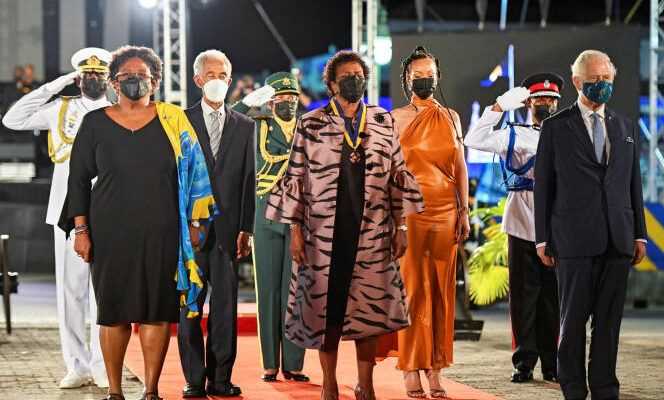Barbados, about thirty kilometers long and twenty wide, is a micro-island-nation located in the east of the Caribbean, 100 kilometers south-east of Martinique. Briefly conquered by the Spaniards at the end of the XVe century, then claimed by the Portuguese, this island fell under the control of the English in the 17the century.
They made it one of their main plantations, a colony devoted to the cultivation of sugar cane, exploiting tens of thousands of slaves from Africa to the point of exhaustion. After the abolition of slavery in the British Empire in 1833, Barbados remained in the British Imperial fold until November 30, 1966, when it became an independent state.
Dame Sandra Mason President
On November 30, 2021, fifty-five years later to be exact, it officially became a republic, renouncing its status as a constitutional monarchy and Queen Elizabeth II – but remaining a member of the Commonwealth. It was a magistrate, Dame Sandra Mason, until now governor general of the country (and representative of the Queen), who took on the office of president – the first of Barbados. The transition, recorded in law, but without a referendum, gave rise to an astonishing ceremony, on November 30, to which Prince Charles was invited. At 95, Elizabeth II has hardly left Windsor Castle since her doctors advised her to limit her travel this fall.
“What is surprising is especially the time it took for Barbados to renounce the constitutional monarchy. Philip Murphy, Director of the Commonwealth Studies Institute
Standing alongside Dame Mason, ex-cricketer Garfield Sobers and singer Rihanna (both island natives, decorated with the Order of National Heroes of Barbados), the Prince of Wales has witnessed in silence, in the tropical night, the descent of the royal standard of the United Kingdom, replaced by the flag of Barbados, which now flies above Parliament in Bridgetown. Then, in a speech evoking the “Atrocities of slavery”, Charles elegantly passed the baton, ensuring that the transition to the republic was a ” new start “ and that he “Would remain deeply devoted to this very special country, to [sa] future prosperity and well-being. I will always consider myself a friend of Barbados ”.
“What is surprising is especially the time it took for Barbados to renounce the constitutional monarchy”, points out Philip Murphy, director of the Institute for Commonwealth Studies, University of London. “If you had asked the palace [de Buckingham] at the end of the 1960s if the former Caribbean colonies would still be constitutional monarchies at the beginning of the 2020s, the answer would certainly have been no: at the time, already, there was a form of consensus on the idea that these States would quickly declare their full independence ”. Kenya, Tanzania or Nigeria became republics very quickly after gaining independence from the British Empire in the early 1960s. Malta and Trinidad and Tobago took longer – ten years or so.
You have 45.5% of this article left to read. The rest is for subscribers only.
